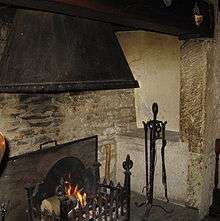Inglenook

An inglenook (Modern Scots ingleneuk), or chimney corner, is a small recess that adjoins a fireplace. The word is formed with ingle, meaning "fireplace" in Old English (from Old Scots or Irish Gaelic aingeal, "angel" or euphemistically "fire"), and nook.
Origin and Use
The inglenook originated as a partially enclosed hearth area, appended to a larger room. The hearth was used for cooking, and its enclosing alcove became a natural place for people seeking warmth to gather. With changes in building design, kitchens became separate rooms, while inglenooks were retained in the living space as intimate warming places, subsidiary spaces within larger rooms.[1]
Inglenooks were prominent features of shingle style architecture and characteristic of Arts and Crafts architecture but began to disappear with the advent of central heating.[1][2] Prominent American architects who employed the feature included Greene and Greene, Henry Hobson Richardson, and Frank Lloyd Wright. British architect Richard Norman Shaw significantly influenced Richardson.[3]
In popular culture
Inglenooks play a large role in Lucy M. Boston's first two Green Knowe novels. In John Stedelman's eponymous 1986 BBC One television adaptation of the first novel, The Children of Green Knowe (1954), Granny has her visitor Toseland (whom she calls "Tolly") "build up a blaze" each evening, before telling him a story. In episode 2, the ghost of Tolly's ancestral namesake (nicknamed "Toby") tells Tolly he and (the ghost of) his brother Alexander had joined Granny and Tolly during storytime the previous night, explaining: "I was in the inglenook; Alexander was in your chair".[4] In the second novel, The Chimneys of Green Knowe (1958), and its film adaptation by Julian Fellowes, From Time to Time (2009), the chimneys themselves play important roles. Perhaps the most famous reference to an inglenook in literature occurs in the final line of John Betjeman's short poem 'In a Bath Teashop', where it has been immortalised as the setting for a tryst.
References
- 1 2 Holt, Stephen. "The Inglenook: A History of Hearth & Home". This Old House. Retrieved 17 January 2012.
- ↑ "What Was the Arts and Crafts Movement?". Historic England. Retrieved 17 October 2015.
- ↑ Flaherty, Carolyn; Conley, Katharine (November 1980). "Cosy Corners". Old-House Journal: 178–179.
- ↑ Boston, Lucy M. (1954 novel) & Stadelman, John (Adaptation) (1986). The Children of Green Knowe. BBC One.